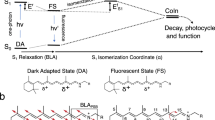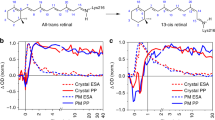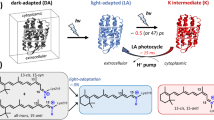Abstract
A COMPARISON between the optical rotatory dispersion curves of rhodopsin before and after irradiation has been previously reported1. Unbleached rhodopsin solutions show a weak Cotton effect in the visible range, and another distinguishable Cotton effect in the ultra-violet range, attributable to the polypeptide conformation (probably α-helix) of the protein moiety, opsin. After bleaching, however, the samples have a simple dispersion curve showing lower values of optical rotation in the visible range. The Cotton effect in the visible range is thus presumably caused by the optical activity of the prosthetic-group conformation (11-cis), although this is not certain. We have made measurements of the circular dichroism of rhodopsin and isorhodopsin (the artificial pigment with a prosthetic group in the 9-cis configuration) in order to elucidate the weak Cotton effect demonstrated by optical rotatory dispersion.
This is a preview of subscription content, access via your institution
Access options
Subscribe to this journal
Receive 51 print issues and online access
$199.00 per year
only $3.90 per issue
Buy this article
- Purchase on Springer Link
- Instant access to full article PDF
Prices may be subject to local taxes which are calculated during checkout
Similar content being viewed by others
References
Kito, Y., and Takezaki, M., Nature, 211, 197 (1966).
Hubbard, R., J. Gen. Physiol., 37, 381 (1954).
Kito, Y., Ishigami, M., and Yoshizawa, T., Biochim. Biophys. Acta, 48, 287 (1961).
Hubbard, R., J. Gen. Physiol., 39, 935 (1956).
Holzwarth, G., and Doty, P., J. Amer. Chem. Soc., 87, 218 (1965).
Hubbard, R., Gregerman, R. I., and Wald, G., J. Gen. Physiol., 36, 415 (1953).
Mislow, K., Glass, M. A. W., O'Brien, R. E., Rutkin, P., Steinberg, D. H., Weiss, J., and Djerassi, C., J. Amer. Chem. Soc., 84, 1455 (1962).
Jurkowitz, L., Loeb, J. N., Brown, P. K., and Wald, G., Nature, 184, 614 (1959).
Crescitelli, F., Mommaerts, W. F. H. M., and Shaw, T. I., Proc. US Nat. Acad. Sci., 56, 1729 (1966).
Stryer, L., and Blout, E. B., J. Amer. Chem. Soc., 83, 1411 (1961).
Ballard, R. E., McCaffery, A. J., and Mason, S. F., Biopolymers, 4, 97 (1966).
Wald, G., and Brown, P. K., J. Gen. Physiol., 37, 189 (1953).
Takagi, T., Aki, K., Isemura, T., and Yamano, T., Biochim. Biophys. Res. Commun., 24, 501 (1966).
Kito, Y., and Takezaki, M., Ann. Rep. Biol. Works, Fac. Sci., Osaka Univ., 14, 83 (1966).
Author information
Authors and Affiliations
Rights and permissions
About this article
Cite this article
TAKEZAKI, M., KITO, Y. Circular Dichroism of Rhodopsin and Isorhodopsin. Nature 215, 1197–1199 (1967). https://doi.org/10.1038/2151197a0
Received:
Issue Date:
DOI: https://doi.org/10.1038/2151197a0
This article is cited by
-
Circular dichroism, optical rotatory dispersion, and absorption studies on the conformation of bovine rhodopsin in situ and solubilized with detergent
Biophysics of Structure and Mechanism (1977)
-
Membrane structure changes in rod outer segments associated with rhodopsin bleaching
Nature (1974)
-
Internal Protonation in Retinylidene Phosphatidylethanolamine and the Red-shift in Rhodopsin
Nature (1969)
-
Absorption Spectrum of Rhodopsin denatured with Acid
Nature (1968)
Comments
By submitting a comment you agree to abide by our Terms and Community Guidelines. If you find something abusive or that does not comply with our terms or guidelines please flag it as inappropriate.



